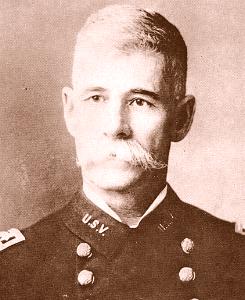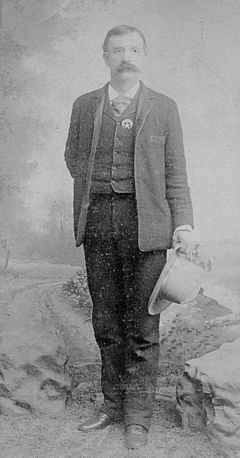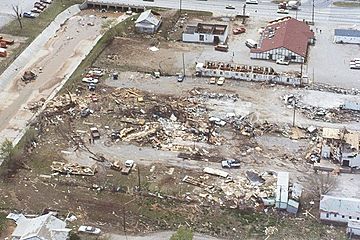History of Lawton, Oklahoma facts for kids
The History of Lawton, Oklahoma tells the story of this city in southwestern Oklahoma. Lawton's journey began in the early 1900s when lands that were once Native American reservations were opened up. The city has grown a lot in population and economy throughout the 20th century, mainly because it's very close to Fort Sill, a major military base.
Contents
How Lawton Began (Before WWII)
Southwest Oklahoma was a special home for many Native American tribes. This was thanks to the rich natural resources found in the nearby Wichita Mountains. These ancient granite mountains, covering about 60,000 acres (243 km²), offered plenty of water, wildlife, and plants. Today, this area is known as the Wichita Mountains Wildlife Refuge. Lawton's story is closely connected to Fort Sill, which was built in 1869 during conflicts in the Indian Territory.
This land was given to the Comanche, Kiowa, and Apache tribes by the Medicine Lodge Treaty in 1867. Fighting continued until Comanche Chief Quanah Parker and his group arrived at Fort Sill in June 1875, ending their struggle.
In 1891, the U.S. Congress formed a group led by David H. Jerome to talk with tribal leaders. They wanted to reach an agreement to allow white settlers to move in. Under pressure, Quanah Parker and other Native American leaders first agreed to sell the land for $1.25 per acre. Each tribal member would receive 160 acres (0.65 km²), and 400,000 acres (1,619 km²) would be set aside for white cattle ranchers. After years of talks and legal steps, President William McKinley announced that the government would take control of 2,000,000 acres (8,094 km²) for less than $1 per acre.
After a survey, three 320-acre (1.3 km²) spots were chosen as town sites for the county seats of Kiowa, Caddo, and Comanche Counties. Lawton became the Comanche County site. It was named after General Henry W. Lawton, who had worked at Fort Sill and helped capture Geronimo. The Apache leader was moved to Fort Sill in 1894 as a prisoner of war. Geronimo was held at the Old Post Guardhouse and stayed in the area until he passed away on February 17, 1909.
Most American cities grow slowly, but Lawton appeared almost overnight. To avoid the problems of earlier "land runs" (like violence and fraud), it was decided to open Lawton with a lottery. On July 10, 1901, a lottery began in El Reno, Oklahoma and Fort Sill. This lottery decided the order for people to claim their homesteads. About 29,888 potential settlers signed up at the Fort Sill land office.
The town itself was divided into 66 blocks to be sold at auction. Two original land claims just south of Lawton's 320 acres were made by James Woods and Martha Helen Beal. These areas became known as the Woods Addition and Beal Addition to Lawton.
On August 6, 1901, the auction for town lots started and lasted for sixty days. A "tent city" had already popped up, and banks, stores, and other businesses quickly opened. Within a year, there were many saloons, and gambling was widespread. In 1902, deputy U.S. marshal Heck Thomas was sent to bring order. He was elected Lawton's first chief of police and served for seven years. Gambling became illegal on November 16, 1907, when Oklahoma became a state.
The Rock Island Railroad reached Lawton on September 25, 1901, and the Frisco Line soon followed. Lawton also had a city streetcar line that ran through downtown and some neighborhoods until the 1940s. Later, early cross-country car routes from 1916 to 1925 passed through Lawton. By the late 1930s, Lawton was connected by paved highways to cities like Oklahoma City and Wichita Falls, Texas.
The fast growth of Lawton led to public health issues, water shortages, and some lawlessness. The first city elections were held on October 24, 1901. Leslie Price Ross was elected mayor. One of the first newspapers, the Lawton Daily Democrat, later became the Lawton Constitution in 1911. Today, the Constitution publishes a morning edition for all of Southwest Oklahoma.
The Bethlehem Baptist Church has a rich history, spanning over a century. Its early members faced many challenges, including segregation. Despite these difficulties, their faith helped build a strong foundation for future generations. The idea for a Baptist church in Lawton's Black Community began in 1901. It was organized by William Scott Sr., C.D. Dewberry, George Williams, and William Garrett, among others, in a barbershop. The church has had 19 pastors, with Reverend O.B. Davis serving for 32 years (1950-1982).
In the early years, most churches in Lawton were in tents or small wooden buildings. Bethlehem was one of the few in a small wooden structure at First and "F" street. In 1907, the church bought land at First and Gore. Later, in 1939, they built a new church at First and Arlington. In 2010, this original Bethlehem Baptist Church building was taken down as part of downtown improvements.
The First Presbyterian Church of Lawton, built in 1902 at 8th Street and D Avenue, is the oldest public building still standing in Lawton. It is listed on the National Register of Historic Places. On January 2, 1902, four public schools opened. The first class of six students graduated from Lawton High School in 1903. Cameron State Agricultural School (now Cameron University) started classes on November 16, 1909, in the basement of the First National Bank. In March 1911, classes moved to the current location on West Gore. The Mattie Beal House at Fifth and Summit was built in 1908 and is also on the National Register of Historic Places.
When the United States entered World War I, Fort Sill and Lawton grew even faster. With plenty of water from Lake Lawtonka, a large military camp called Camp Doniphan was built. It was active until 1922. In 1911, the School of Fire for the Field Artillery opened at Fort Sill. It still operates today as the U.S. Army Field Artillery School.
From the stock market crash in October 1929 through the 1930s, Lawton faced tough economic times. Dust from dust storms further north, harsh winters, and joblessness caused many problems. However, the decision in late 1930 to keep the U.S. Army Field School permanently at Fort Sill led to new construction. Fort Sill leaders helped with Civilian Conservation Corps and Works Progress Administration projects throughout the 1930s. These projects included work on dams and buildings at the Wichita Mountains Wildlife Refuge, the County Courthouse, and the road to the top of Mount Scott.
Lawton After World War II (1946–1959)
After World War II, Lawton's population grew quickly and steadily. From 1930 to 1940, the population increased from 18,055 to 34,757. By 1960, it reached 61,697. In the 1950s, many important public buildings were constructed. These included the new Lawton High School (1954), Tomlinson Junior High School (1957), Comanche County Memorial Hospital (1951), and several elementary schools. Other additions were the Lawton Municipal Airport (1955), McMahon Auditorium (1955), and the National Guard Armory (1955). Work also began on the Museum of the Great Plains in 1959. The Hotel Lawtonian opened downtown in 1955. It was owned by the city for many years and is now an apartment building. The city also expanded its land area, with new homes appearing in the western, northwestern, and southeastern parts of Lawton.
Lawton's television station, KSWO-TV Channel 7, began broadcasting in March 1953. It was an ABC network station. At the same time, two TV stations started in Wichita Falls, Texas, just across the Red River. This meant Lawton and nearby areas had access to three TV stations, which was rare for a city its size back then.
Lawton's huge growth in the late 1940s and 1950s made city leaders look for more water. They needed to add to the water supply from Lake Lawtonka. In the late 1950s, the city bought large areas of land along East Cache Creek to build a new lake. A dam was built in 1959. Lake Ellsworth, named after former Lawton mayor C.R. Ellsworth, was dedicated in the early 1960s. It provided more water, recreational activities, and helped control floods along Cache Creek.
Lawton in the 1960s
The 1960s saw the building of Eisenhower (1962) and MacArthur (1969) high schools, along with Eisenhower Junior High School (1967) and several elementary schools. New shopping centers also opened, including Cache Road Square in 1961. Fort Sill also grew a lot during the 1960s, partly because of the Vietnam War. In 1969, Fort Sill celebrated its 100th birthday with many events.
The City of Lawton continued to grow significantly in both size and population. In 1966, the city added several miles of land to its east, northeast, west, and northwest. This was to make room for new homes and businesses. Before that, Lawton's eastern border was generally near East Cache Creek. The western border, which was around 38th Street in the 1950s, moved west to 67th Street by 1961, and then to 82nd Street in 1966.
Besides building new schools, the Lawton Public Schools system worked to follow federal rules about desegregation. Schools in mainly Black neighborhoods, like Douglass Junior-Senior High School and Dunbar Elementary School, were closed. Students from these areas were bused to schools in other parts of the city.
Other changes in the 1960s included turning the old Emerson School building into a new city hall, downtown post office, and police station. Cameron University expanded with a new football stadium, library, and dorms. The H. E. Bailey Turnpike opened in 1964. The Pioneer Expressway, a free section of Interstate 44, was also finished at the same time, connecting Lawton to Oklahoma City and Wichita Falls.
Wayne Gilley was Lawton's mayor for most of this decade, first elected in 1961. He served until 1989, except for a four-year period from 1971 to 1975.
The 1970s and Beyond
In the 1970s, Lawton's downtown area changed a lot because of urban renewal projects. Many old buildings in the city center were torn down to make way for a new enclosed shopping mall.
After most of downtown Lawton was cleared by the mid-1970s, construction began on the new Central Mall. This mall opened in 1980 with large stores like Sears, J.C. Penney, and Dillard's, plus many smaller shops. The downtown renewal project also allowed for a new Lawton Public Library, finished in 1973, new buildings for City National Bank in 1976, and a new downtown post office that opened in 1980.
This decade also saw the opening of Great Plains Vo-Tech in 1971. A new Comanche County Courthouse was completed in 1974. Cameron University, Comanche County Memorial Hospital, and Southwestern Hospital all expanded. Also, the Goodyear Tire and Rubber Company bought land west of the city and opened a large tire factory in 1979.
After Lake Ellsworth was built in the early 1960s, city leaders realized Lawton would need even more water in the future. In the late 1970s, after Waurika Lake was built southeast of Lawton, the city made a deal to get water from Waurika Lake. A pipeline was built to move water between Lake Ellsworth and Waurika Lake.
Lawton was hit by a tornado on the afternoon of April 10, 1979. This day is known locally as "Terrible Tuesday." The tornado was part of a larger storm system. It caused damage in the southeastern part of the city, near 2nd and Lee Boulevard. Sadly, 3 people died and 109 were injured. Many businesses and homes were badly damaged or destroyed.
On June 23, 1998, Lawton grew in both size and population when it officially added neighboring Fort Sill. The military base had been outside the city limits until this change.




